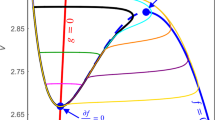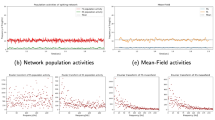Abstract
This paper describes some analytical models for the system which regulates the daily eclosion rhythm of the drosophila. A general topological model is described which can simulate practically all the known experimental results about the behavior of the system under various light stimuli. From that a more specific model is proposed which can shortly be described as follows: The system contains a basic oscillator whose output is a substances. This is produced in the presence of an enzymer. During part of the cycler is deactivated ands dissipates until it reaches a lower level whenr is reactivated again. Light has the effect of deactivatingr immediately. The substances causes the production of a second substanceq which triggers a series of reactions leading to eclosion when it exceeds a threshold. The main oscillator (s—r) is temperature-compensated, but the production ofq is accelerated in the presence of light or higher temperature.
Similar content being viewed by others
Literature
Aschoff, J. 1965. “Response Curves in Circadian Periodicity.” InCircadian Clocks, J. Aschoff, ed. Amsterdam: North Holland Publishing Company, 95–111.
Barlow, J. S. 1962. “A Phase-Comparator Model for the Diurnal Rhythm of Emergence of Drosophia.”Ann. of the New York Acad. of Sci.,98, 788–805.
Bruce, V. G. 1960. “Environmental Entrainment of Circadian Rhythms.” InCold Spring Harbor Symposia on Quantitative Biology: Biological Clocks,25, 29–47.
Burkhardt, D. 1959. “Effects of Temperature on Isolated Stretch-Receptor Organ of the Crayfish.”Science,129, 392–393.
Christiansen, J. A. 1961. “Periodic Enzymic Reactions and Their Possible Applications.”Advances in Enzymol.,23, 83–127.
Danzinger, L. and G. L. Elmergreen. 1957. “Mathematical Models of Endocrine Systems.”Bull. Math. Biophysics,19, 9–18.
Enright, J. T. 1965a. “Accurate Geophysical Rhythms and Frequency Analysis.” InCircadian Clocks, J. Aschoff. ed. Amsterdam: North Holland Publishing Company, 31–42.
— 1965b. “The Search for Rhythmicity in Biological Time Series.”J. Theoret. Biology,8, 426–468.
Nemytskii, V. V. and V. V. Stepanov. 1960.Qualitative Theory of Differential Equations. Princeton, N. J.: Princeton University Press.
Ottesen, E. A. 1965. “Analytical Studies on a Model for the Entrainment of Circadian Systems.” Unpublished A. B. Thesis, Princeton University.
Pavlidis, T. 1966. “Studies on Biological Clocks.” Talk presented at the 133rd A.A.A.S. Meeting, Dec. 28, Washington, D.C.
Pittendrigh, C.S. 1954. “On Temperature Independence in the Clock System Controlling Emergence Time in Drosophila.”Proc. Natl. Acad. Sci., U.S.,40, 1018–1029.
— and V. G. Bruce. 1959. “Daily Rhythms as Coupled Oscillator Systems and Their Relation to Thermoperiodism and Photoperiodism.” InPhotoperiodism and Related Phenomena in Plants and Animals, R. Withrow, ed. Washington, D.C.: American Assoc. for the Advancement of Science, 475–505.
Pittendrigh C. S.. 1960. “Circadian Rhythms and the Circadian Organization of Living Systems.” InCold Spring Harbor Symposia on Quantitative Biology: Biological Clocks,25., 159–184.
— and D. H. Minis. 1964. “The Entrainment of Circadian Oscillations by Light and Their Role as Photoperiodic Clocks.”Am. Naturalist,98, 261–294.
—. 1965. “On the Mechanism of the Entrainment of a Circadian Rhythm by Light Cycles.” InCircadian Clocks, J. Aschoff, ed. Amsterdam: North Holland Publishing Company, 277–297.
— 1966a. “The Circadian Oscillation in Drosophila Pseudoobscura Pupae: A Model for the Photoperiodic Clock.”Z. für Pflanzenphysiol.,54, 275–307.
Pittendrigh, C. S. 1966b. Personal communication.
Pittendrigh, C. S., E. A. Ottesen and T. Pavlidis. 1967. “Stable and Non-Stable Equilibria in the Entrainment of Circadian Systems by Light.” In press.
Skopic, S. 1966. “Temporal Organization in the Development of Drosophila Pupae.” Ph.D. Thesis, Princeton University, Princeton, New Jersey.
Strahm N. D. 1964. “Mathematical Models for Circadian Rhythms.” M.S. Thesis, Massachusetts Institute of Technology, Cambridge, Massachusetts.
Wever, R. 1962. “Zum Mechanismus der biologischen 24-Stunden Periodik.”Kybernetic,1, 139–154.
— 1963. “Zum Mechanismus der biologischen 24-Stunden Periodik: II.”Kybernetik 1, 213–231.
— 1964. “Zum Mechanismus der Biologischen 24-Stundern Periodik: III.”Kybernetik,2, 127–144.
— 1965. “A Mathematical Model for Circadian Rhythms.” InCircadian Clocks, J. Aschoff, ed. Amsterdam: North Holland Publishing Company, 47–63.
Author information
Authors and Affiliations
Rights and permissions
About this article
Cite this article
Pavlidis, T. A mathematical model for the light affected system in the drosophila eclosion rhythm. Bulletin of Mathematical Biophysics 29, 291–310 (1967). https://doi.org/10.1007/BF02476901
Received:
Issue Date:
DOI: https://doi.org/10.1007/BF02476901




